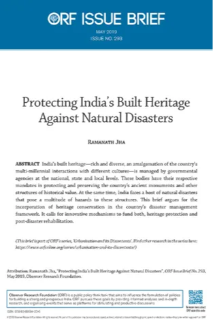India’s built heritage—rich and diverse, an amalgamation of the country’s multi-millennial interactions with different cultures—is managed by governmental agencies at the national, state and local levels. These bodies have their respective mandates in protecting and preserving the country’s ancient monuments and other structures of historical value. At the same time, India faces a host of natural disasters that pose a multitude of hazards to these structures. This brief argues for the incorporation of heritage conservation in the country’s disaster management framework. It calls for innovative mechanisms to fund both, heritage protection and post-disaster rehabilitation.
This brief is part of ORF’s series, ‘Urbanisation and its Discontents’. Find other research in the series here:
Introduction
India is an ancient civilisation and one of the richest nations in terms of cultural heritage—or those physical artifacts and intangible legacies that are inherited from the past and which remain highly significant to generations of the present and the future. Indeed, India’s heritage can be described as multi-millennial in age, oceanic in size, and rainbow-like in variety. After all, the ‘India’ as we know it today is a result of thousands of years of assimilating diverse cultures.
This richness is visible in both the tangible heritage—monuments and other structures of historical value—and the intangible heritage comprising language, music and dance, amongst many other practices and customs. By their very nature, these physical and intangible artifacts of heritage belong to every Indian and, by extension, all of humanity. Unfortunately, India’s built heritage is under constant threat from the various natural disasters that visit the country every year. Even as the protection of India’s heritage is covered by various laws, there is much scope for improvement in terms of heritage conservation. This brief calls for the integration of the country’s heritage conservation framework with that of disaster management.
The objective of this article is to examine issues of conservation in the event of a disaster. These include the question of how to conserve, how much to conserve and how to finance conservation. The brief also focuses on the additionalities that need to be factored in from the point of view of protecting urban heritage from disasters. In view of the significance of heritage in a nation’s life, it is critical to have a strategy in place that deals specifically with what needs to be done to preserve heritage in the event of a disaster.
India’s Heritage Laws: A Timeline
India’s built heritage are well-protected by Article 49 of the Constitution: “It shall be the obligation of the State to protect every monument or place or object of artistic or historic interest, (declared by or under law made by Parliament) to be of national importance, from spoilation, disfigurement, destruction, removal, disposal or export, as the case may be.”[1] Further, Article 51 A (f) states: “It shall be the duty of every citizen of India to value and preserve the rich heritage of our composite culture; and (g) to protect and improve the natural environment including forests, lakes, rivers and wild life, and to have compassion for living creatures.”[2]
The country’s earliest heritage laws were the Bengal Regulation XIX of 1810 and the Madras Regulation VII of 1817. In 1863 Act XX was passed, empowering the government to conserve structures of historical or architectural value. Later, the Ancient Monuments Preservation Act, 1904 allowed government authority over privately owned heritage structures. The Antiquities Export Control Act, 1947 and Rules was passed more than four decades later to regulate the export of antiquities. In 1951, the Ancient and Historical Monuments and Archaeological Sites and Remains (Declaration of National Importance) Act replaced the Ancient Monuments Preservation Act, 1904 and later was supplanted by the Ancient Monuments and Archaeological Sites and Remains Act 1958. The latter provided for the preservation of ancient and historical monuments and archaeological sites and remains of national importance, for the regulation of archaeological excavations, and for the protection of sculptures, carvings and other like objects.
An amendment in 2010 provided for the constitution of the National Monument Authority charged with the grading and classifying of protected monuments and areas. The Antiquities and Art Treasures Act 1972 was enacted for effective control over the moveable cultural property consisting of antiquities and art treasures. This Act repealed the 1947 Act. India’s commitment to heritage was further emphasised when it became a signatory to UNESCO’s World Heritage Convention for the protection of global and national heritage.
A number of state heritage laws have also been enacted in independent India. For instance, the Ancient and Historical Monuments and Archaeological Sites and Remains Preservation Act, 1956 of Uttar Pradesh provides for the “preservation of ancient and historical monuments and archaeological sites and remains in (the state) other than those declared by Parliament by law to be of national importance”. In West Bengal, the Heritage Commission Act, 2001 provides “for the establishment of a Heritage Commission in the State of West Bengal for the purpose of identifying heritage buildings, monuments, precincts and sites and for measures for their restoration and preservation”. Other similar laws are the Tamil Nadu Ancient Monuments and Archaeological Sites and Remains Act, 1966; the Hampi World Heritage Area Management Authority Act, 2002; the Orissa Ancient Monuments and Preservation Act, 1956; the Rajasthan Monuments, Archaeological Sites and Antiquities Act, 1961; and the Madhya Pradesh Ancient Monuments and Archaeological Sites and Remains Act, 1964.
At the central level, nationally protected monuments fall under the jurisdiction of the Archaeological Survey of India (ASI). It functions under the Ministry of Culture and is responsible for archaeological research and conservation and preservation of around 3,650 monuments categorised as “national heritage”. It administers these under the AMASR Act. The Directorate of State Archaeology and Museums looks after state-protected monuments. Besides heritage conservation, the directorates conduct excavation and exploration within the state, and they organise exhibitions, workshops and seminars. In addition, many cities put in their own effort towards protecting urban heritage by declaring a City List of such heritage items that are of local significance and are administered by the local government. Mumbai, for instance, was the first city to come up with such a list in the mid-1990s.
These laws and regulations, however, have no specific reference to disasters where heritage sites are involved. This is unfortunate, given that the importance of a country’s built heritage cannot be overemphasised. There is no dearth of examples in other parts of the world of how the subject of conservation of heritage should be taken seriously. A nation’s heritage, after all, bestows upon its people both identity, and pride in their past; it connects the past generations to the present and the future. For India, too—home to a multitude of faiths and cultures—the celebration of the country’s cultural diversity is a means of building solidarity.
Kenya, for example, puts a value to its wildlife. In one national park, the Masai Mara National Reserve, each lion is worth US $27,000 per year, and each elephant herd, US $610,000; these calculations are based on visitor revenues per year. Moreover, each hectare of the park is estimated to yield US $40 per year, which is 50 times more than the net profits expected from the land if it were to be used for agricultural purposes.[3] In the US, it has been found that visitors to historic sites and others of cultural value tend to spend more and stay longer than other types of travellers.[4] Several US cities, in fact, have begun to invest in “heritage tourism”. Meanwhile, in Europe and Asia, many cities have also started to include heritage resources on their urban regeneration agendas. With the objective of “valorizing” European cultural heritage, for instance, an investment of 78 million euros was made by the European Union in Pompeii, a historical site near Naples in Italy.[5] Similarly, in 2014, the Singapore Government decided to pump in SD 65 million over five years to revamp its museums and cultural institutions.[6]
India’s Disaster Risks
India is amongst the countries in the world with the highest risk of natural disasters, ranking third in the number of disaster events, second in the number of disaster victims, and fifth in economic damage on account of natural disasters.[7] These disasters are in the form of earthquakes, fires, floods, cyclones and drought. In recent years, climate change has only increased the risk of disasters.
These many forms of disasters put India’s built heritage at serious risk. Earthquakes, floods, and tsunamis threaten serious damage to monuments and other historical structures. In the Gujarat earthquake of 2001, officials reported that 21 federally registered monuments across Kutch were destroyed. These included temples dating back to the 8th and 9th centuries. The 123-year-old museum in the flattened town of Bhuj was reduced to rubble.[8]
India is not alone here. In 2011, for instance, an earthquake in Christchurch in New Zealand destroyed many iconic heritage buildings in the city. At the end of a full damage assessment, it became clear that the costs of rebuilding would not permit many of them to be restored, leading the prime minister to remark that after reconstruction, “Christchurch will be a very different city.”[9] On 25 April 2015, Nepal’s capital Kathmandu, a “city of temples”, was reduced to a “city of tents” following a massive earthquake. The valley surrounding Kathmandu is a designated UNESCO World Heritage site, known for its historic monuments, temples, and stupas. Many of these iconic sites were affected by the quake. For instance, Bhaktapur’s Durbar Square, a medieval township, was severely damaged by the earthquake.[10] Following the disaster, restoration and reconstruction was long and arduous, and gaps in heritage strategies were noticed that adversely impacted restoration.[11]
There are also the additional risks of manmade disasters that may occur because of neglect and indifference. A case in point is the adverse impact on the foundations of the Taj Mahal by the polluted Yamuna river.[12]
Integrating Heritage Preservation in Disaster Management
Historically, disaster management in India was viewed from the lens of rescue, relief and rehabilitation. Over the years, there was a shift in focus to prevention, and in 2009 the Government of India issued a comprehensive National Disaster Management Framework that combines pre-disaster aspects of prevention, mitigation and preparedness along with post-disaster issues of response, recovery and reconstruction. The disaster management framework is headed by the National Disaster Management Authority,[13] and includes components that are administered by states, districts and local governments.
However, heritage conservation remains absent from the country’s disaster management framework. Disaster managers have traditionally accorded low priority to the protection of heritage places. In the event of a disaster striking a heritage area, personnel from the disaster agency cordon off the site and prevent the entry of unauthorised persons.[14] Heritage personnel, therefore, are also barred from entering the disaster site, even if it involved a heritage structure.
The imperative is to integrate the rehabilitation of the heritage structure in Disaster Management (DM) at the national and local levels. This should be done in a manner that does not impact the efforts, for instance, to save lives and restore normalcy. In the absence of such integration, heritage structures may get tampered with during any of the stages of rescue and rehabilitation; it also becomes difficult to salvage the heritage structure. Containment and response efforts put the heritage site at risk, usually due to ignorance rather than malice on the part of the disaster manager or the property owners.
Simultaneously, Disaster Risk Management (DRM) policies must incorporate heritage management policies and plans. This will ensure a more effective approach in which stakeholders focus on their respective responsibilities. It is crucial to establish an enabling legal, policy, institutional, and operational framework for heritage, and to outline responsibilities and coordination protocols for various stakeholders and across the spectrum of DRM practices—from risk assessment to preparedness, response, and recovery. At the same time, greater coordination between the different stakeholders, including the private sector and the local communities, is needed beyond the period of disaster. Post-disaster recovery is a sensitive time when additional factors such as debris removal, theft, misclassification, and further disaster events can amplify the impact of the initial disaster.
It would also do well to develop a risk map that is based on an extensive alphanumeric and cartographic database of cultural assets. This risk map should function as the main reference tool for safeguarding heritage in times of disasters. In Australia, for instance, a review of the heritage conservation register, which formed the basis for protection measures and funding, found gaps and inconsistencies in the data. This impacted the effectiveness of government expenditure. In response, in 2006 the National Coordinated Heritage Agenda identified establishment of data collection standards as a priority project.[15]
Heritage Conservation in Disasters: Key Challenges
Heritage Grading and Documentation
It is important that a proper identification and grading of heritage sites are done to allow the determination of value of a structure. Grade I given to a heritage site, for instance, would mean that the heritage structure is of great significance and would brook the least interference or alteration to the structure. Grade II buildings would be particularly important buildings that are especially interesting, warranting all possible effort to save them. “Heritage Grade-I richly deserves careful preservation, Heritage Grade-II deserves intelligent preservation”.[16] The older a building is, and the fewer the surviving examples of its kind, the more likely it is to have special interest. Where a building qualifies for listing primarily on the strength of its special architectural interest and where a substantial number of buildings of a similar type exist, in such cases the policy would be to list only the most representative or most significant examples of the type.
Equally crucial is the prioritisation from the point of view of vulnerability to disaster. It is only natural that certain sites and structures, for ‘locational’, ‘material content’ and other reasons, have greater susceptibility to disaster. All other strategies, including financial, would then have to factor in such prioritisation. Indeed, this is an essential piece of information that must guide all efforts at precaution. Additionally, the effort at preventive retrofitting of such prioritised structures would be an important step for heritage agencies. This would allow mitigation of the consequences of future failure, more complicated and costly restoration or complete helplessness in the face of a structural state of the heritage site or structure that renders it beyond repair.
It is also important to undertake adequate documentation of heritage structures. Such documentation should include the determination of potential risks to heritage structures based on their location and other characteristics. The process would involve the use three-dimensional (3D) mapping and GIS, to assist in the documentation of the technical details of the heritage structures. 3D models, viewable in a virtual reality environment, provide detailed and measurable information about each structure in the event there is damage that needs to be repaired. A spatial database can be updated in real time and improve monitoring and protection of local heritage and offer the possibility to involve the members of local communities in heritage management.
Moreover, information should be available about the current status of heritage sites and their analysis in terms of preservation priorities and material procurement plan in case they are affected by a disaster. The Swiss protection programme, for example, includes detailed maps on which inventoried cultural properties are located, and which depict properties in both urban and rural settings.
Skilled Workforce
The restoration of heritage sites that are damaged by natural disasters, requires highly skilled personnel to undertake judiciously planned interventions. The architect who heads the team should have specialised knowledge and skills in conservation architecture. Trained conservation architects have deep knowledge of the processes and techniques by which the material, historical, and design integrity of heritage structures could be preserved without impairing their original aesthetics and character. Masons, artisans and other skilled personnel who are familiar with heritage protection would have to be readily available.
It is also important to promote capacity-building programmes for the citizens who live in the vicinity of important structures; a citizenry that is aware, and trained, would be the frontliners in the event of a disaster.
Financing
Restoration work needs plenty of time and financial resources. As mentioned earlier, following the 2011 Christchurch earthquake, the costs that were calculated for restoring many of the heavily damaged structures made little economic sense for the decision-makers. Indeed, in such a situation where people have been killed and homes have been destroyed, heritage structures will not be accorded the top priority.
In India, to begin with, built heritage is under-funded by either public or private sources. Neither are banks and financial institutions keen in extending loans for the protection and development of heritage assets. Banks are wary about putting their money into heritage projects, as the financial viability of such projects is not always easy to establish. “Linkages between heritage conservation and economic development, particularly in the context of promoting tourism, are still being understood, leading banks to be cautious in funding urban heritage conservation projects”. [17]
Heritage properties that are under private ownership pose a particular problem: as they are averse to the listing of their properties as “heritage”, they do not fall under the purview of government conservation agencies. In Mumbai, there is an attempt to address such dissonance through the concept of heritage TDR (Transfer of Development Rights) embedded in the Development Control and Promotion Rules of Mumbai 2034. Under this provision, heritage property owners are given the same degree of incentives as those whose lands are reserved for public amenities under the Accommodation Reservation policy. Additionally, the Government of Maharashtra, in the Heritage Regulations of Greater Bombay 1995 provided for a Repair Fund for heritage structures. It stated: “With a view to give monetary help for such repairs a separate fund may be created, which would be kept at the disposal of the Bombay Municipal Commissioner, who will make disbursement from the funds in consultation with Heritage Conservation Committee. Provision of such a fund may be made through District Planning and Development Council (DPDC) Budget”. Unfortunately, however, this regulation has remained entirely on paper with no revenues coming from the DPDC.[18]
The following are some of the potential sources of funding for the preservation of India’s built heritage, especially in the context of natural disasters.
- Cess from tourism receipts. Some heritage sites have the potential to generate tourism and their upkeep can help achieve financial viability. Cess from tourism receipts can be collected and contributed towards a heritage fund. Furthermore, in such areas, private sector involvement in maintenance and management may be relatively easier to obtain. The recent case of private-sector involvement in the management of the Red Fort in Delhi is an example. While private participation in this instance is for regular maintenance of the fort, it also allows funds to be saved and diverted to other heritage conservation, including heritage restoration following disasters.
- Some heritage sites, despite their historical or architectural significance, have little economic potential, if at all. In such cases, philanthropy could be a way of finding financial resources. The ambit of activities under CSR (corporate social responsibility), as well as the funds available to MPs, MLAs and municipal corporations, need to be broadened to include spending on heritage. For example, the principle of cross-subsidisation is being used by the Development Plan Mumbai 2034 by earmarking two markets to be constructed as “heritage markets”. Income generated from these markets would be directed to a separate Heritage Maintenance account and will be used to maintain heritage buildings when necessary.[19]
- International donors and crowdsourcing. It should also be possible to seek monetary assistance from the World Heritage Fund.[20] Citizens could come forward with voluntary contributions of money, skill and expertise. Other means such as crowdsourcing could provide handsome sums of money.
- It may be worthwhile to take out insurance for heritage structures that are considered as high-priority in terms of significance and disaster risk.
Conclusion
The Government of India has formulated and disseminated detailed guidelines for disasters, as well as sector-wise National Plans of Action that correspond to such calamities. It is important that similar guidelines are also issued with regards to heritage management during disasters; these guidelines should incorporate the suggestions made in this brief. This would assist the formulation of state and local policies and procedures for heritage protection and conservation at the state and local levels. It would also prod the states and urban local bodies (ULBs) into carrying out vital documentation of heritage assets and pre-disaster studies and plans. These would help inform the proper handling of heritage sites following a disaster and enable the proper restoration of damaged built heritage.
ULBs have a particularly important role in the entire challenge of incorporating heritage conservation in disaster management. After all, India’s built heritage is preponderantly located in what are now classified as urban areas. As urbanisation continues, more of the country’s tangible heritage would get covered within the boundaries of ULBs. These cities will only continue to grow and become more dense, making it even more challenging to protect heritage structures from urban growth. ULBs, therefore, must be sensitised with regards to the built heritage under their jurisdiction and their responsibilities.
The views expressed above belong to the author(s). ORF research and analyses now available on Telegram! Click here to access our curated content — blogs, longforms and interviews.

 PDF Download
PDF Download



 PREV
PREV



